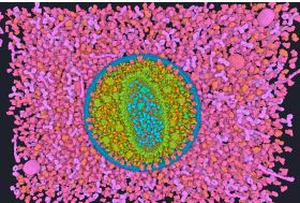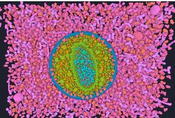Information
- Publication Type: Bachelor Thesis
- Workgroup(s)/Project(s):
- Date: March 2017
- Date (Start): 12. October 2016
- Date (End): 23. March 2017
- Matrikelnummer: 1226847
- First Supervisor: Ivan Viola

Abstract
Modeling of microorganisms is a cumbersome task, when biologists want to create a
visual representation of a certain microorganism. To correctly model structures on atomic resolution, each molecule (for example proteins and lipids) has to be placed at its correct position. For microorganisms of larger dimensions the modeling process takes a very long time, at this point an improved modeling approach is required. It would be possible to create a rule-based modeling approach, but usually rules restrict the final outcome and
produces repeating patterns. Therefore a tool that places molecules based on statistical evaluations and foresight was the main idea behind this project. The tool should allow for modeling complex organisms on molecular resolution by placing a minimal amount of examples and generalizing similar entities. A decision tree as learning structure evaluates the user’s actions, learns from them and reorganizes the whole structure. With this approach the user should be able to model complex cellular structures in as few steps as
possible, also more complex actions, such as orientation towards a certain reference point, clusters, varying distribution united a real-time editor should improve the modeling task significantly.
Additional Files and Images
Additional images and videos
Additional files
Weblinks
No further information available.
BibTeX
@bachelorsthesis{Mitterhofer_2017,
title = "Modeling Microorganisms",
author = "Lukas Mitterhofer",
year = "2017",
abstract = "Modeling of microorganisms is a cumbersome task, when
biologists want to create a visual representation of a
certain microorganism. To correctly model structures on
atomic resolution, each molecule (for example proteins and
lipids) has to be placed at its correct position. For
microorganisms of larger dimensions the modeling process
takes a very long time, at this point an improved modeling
approach is required. It would be possible to create a
rule-based modeling approach, but usually rules restrict the
final outcome and produces repeating patterns. Therefore a
tool that places molecules based on statistical evaluations
and foresight was the main idea behind this project. The
tool should allow for modeling complex organisms on
molecular resolution by placing a minimal amount of examples
and generalizing similar entities. A decision tree as
learning structure evaluates the user’s actions, learns
from them and reorganizes the whole structure. With this
approach the user should be able to model complex cellular
structures in as few steps as possible, also more complex
actions, such as orientation towards a certain reference
point, clusters, varying distribution united a real-time
editor should improve the modeling task significantly.",
month = mar,
address = "Favoritenstrasse 9-11/E193-02, A-1040 Vienna, Austria",
school = "Institute of Computer Graphics and Algorithms, Vienna
University of Technology ",
URL = "https://www.cg.tuwien.ac.at/research/publications/2017/Mitterhofer_2017/",
}

 Bachelor Thesis
Bachelor Thesis image
image

